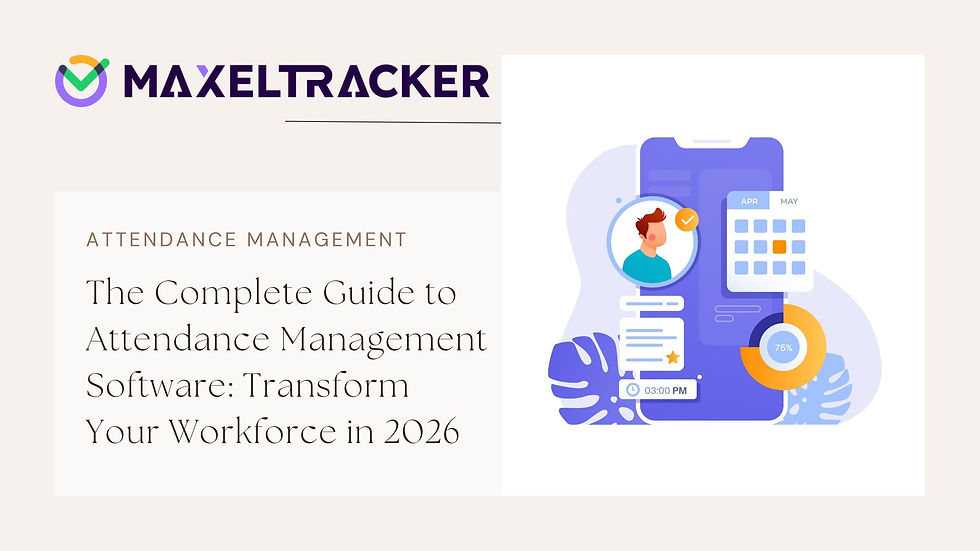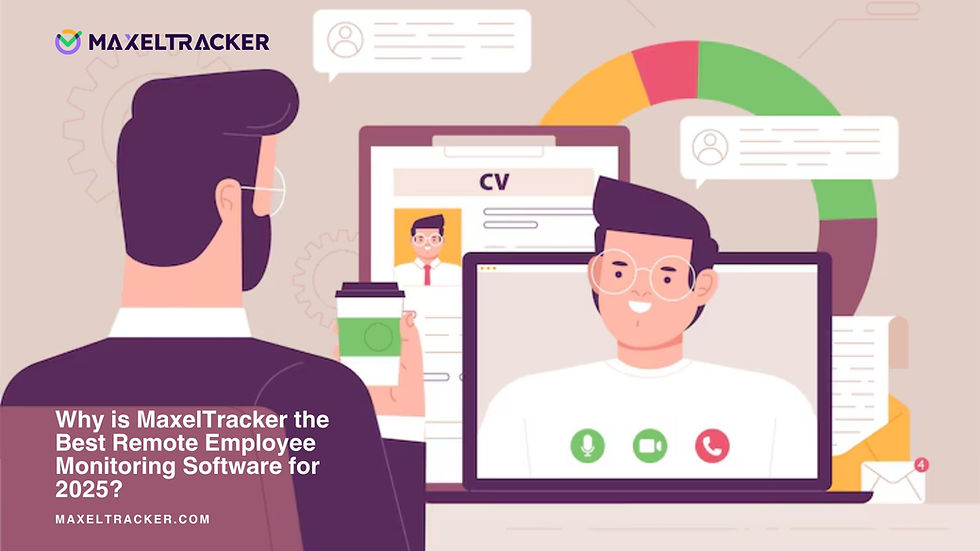Best Employee Monitoring Software Reviews of 2025
- maxeltracker
- Apr 22
- 13 min read

As remote work and digital operations define the modern workplace, employee monitoring software has evolved from a niche solution to an essential business tool. In 2025, these platforms offer unprecedented insights into productivity, security, and operational efficiency, but choosing the right solution requires careful consideration of features, privacy concerns, and implementation strategies.
Our comprehensive review examines the leading employee monitoring solutions available this year. It evaluates their strengths, weaknesses, and ideal use cases to help businesses make informed decisions about this increasingly important technology investment.
Why Trust This Guide?
Our team has spent over 400 hours researching, testing, and evaluating the most popular employee monitoring solutions on the market. Unlike many review sites, we don't accept paid placements or sponsored content that might skew our recommendations. Each software platform underwent rigorous real-world testing across multiple business environments, from small startups to enterprise-level organizations.
We've consulted with IT security specialists, human resource professionals, and business productivity experts to develop a comprehensive evaluation framework that considers technical capabilities alongside practical implementation concerns. Our recommendations reflect both objective performance metrics and subjective user experience factors that matter in day-to-day operations.
Additionally, we've incorporated feedback from actual businesses using these solutions, gathering insights about long-term reliability, customer support quality, and return on investment that can only be discovered through extended use.
Our Selection Process Explained
Our evaluation methodology follows a structured approach designed to identify solutions that balance functionality, usability, and value. We began by identifying 27 employee monitoring platforms with significant market presence, then narrowed our focus to 15 solutions that met our baseline criteria for security compliance, cross-platform compatibility, and customer support standards.
Each qualifying solution underwent a three-phase testing process. First, we evaluated core functionality and feature completeness against industry benchmarks. Next, we assessed user experience factors including interface design, reporting capabilities, and administrative controls. Finally, we examined implementation requirements, scalability options, and total cost of ownership to determine the overall value proposition.
Solutions were scored across 42 distinct evaluation points, with particular emphasis on data security, privacy compliance, accuracy of monitoring capabilities, and administrative flexibility. Only platforms scoring above 80% in our comprehensive assessment qualified for inclusion in our final recommendations.
Top Employee Monitoring Software Options
After extensive testing, Teramind emerged as our top overall choice for 2025, offering an exceptional balance of comprehensive monitoring capabilities, an intuitive user interface, and robust security features. Its AI-powered productivity analytics provide actionable insights without overwhelming administrators with data, while its flexible deployment options accommodate both cloud-first and on-premises security requirements.

For small to medium businesses, ActivTrak delivers impressive value with its streamlined approach to productivity monitoring. The platform's focus on team analytics and workflow optimization makes it particularly suitable for organizations prioritizing performance improvement over strict surveillance. Its transparent pricing model and minimal IT overhead make it accessible even for businesses without dedicated technical staff.
Enterprise organizations with complex compliance requirements should consider Veriato Cerebral, which offers the most comprehensive risk management capabilities we evaluated. Its advanced user behavior analytics can identify potential security threats and policy violations before they escalate, while its granular permissions system enables precise control over monitoring parameters across different departments and roles.
Understanding Employee Monitoring Software
Definition and Functionality
Employee monitoring software encompasses applications designed to track, record, and analyze workplace activities across digital environments. Modern solutions extend far beyond simple time tracking, incorporating sophisticated capabilities for application usage analysis, content filtering, communication monitoring, and behavioral analytics. These platforms typically operate by installing agents on endpoint devices or through browser-based tracking mechanisms that collect data about user activities.
The core functionality of these systems centers on visibility, providing managers and administrators with insights into how time and digital resources are being utilized. This includes tracking active work hours, documenting application and website usage, monitoring communication channels, and in some cases, recording screen activity or keystrokes. Advanced platforms incorporate machine learning algorithms that establish baseline behavior patterns and flag anomalies that might indicate security risks or productivity issues.
While functionality varies significantly between solutions, comprehensive platforms typically offer both real-time monitoring capabilities and historical analytics that help organizations identify trends, optimize workflows, and make data-driven decisions about resource allocation and policy development.
Importance of Modern Workplaces
The shift toward remote and hybrid work models has fundamentally changed how businesses manage operations and evaluate performance. Without traditional in-person supervision, organizations increasingly rely on monitoring tools to maintain operational visibility and ensure consistent productivity across distributed teams. This transition has accelerated the adoption of digital monitoring solutions across industries previously resistant to such technologies.
Beyond addressing remote work challenges, remote employee monitoring software has become integral to security and compliance strategies. With data breaches averaging $4.45 million in costs according to IBM's 2023 report, organizations face mounting pressure to protect sensitive information and demonstrate due diligence in security practices. Monitoring solutions provide essential capabilities for identifying potential insider threats, preventing data exfiltration, and documenting compliance with regulatory requirements.
The competitive landscape has also driven adoption as businesses seek productivity advantages through workflow optimization and resource allocation. By identifying inefficient processes and providing objective performance metrics, monitoring tools enable continuous improvement initiatives that can significantly impact operational effectiveness and bottom-line results.
Benefits of Employee Monitoring Software
Increased Productivity and Accountability
Properly implemented monitoring solutions typically yield measurable productivity improvements through several mechanisms. The awareness effect—employees' knowledge that their activities are being tracked—naturally encourages more focused work habits and reduces time spent on non-work activities. Our research indicates that organizations implementing comprehensive monitoring solutions report productivity gains averaging 22% within the first six months of deployment.
Beyond the awareness effect, monitoring tools provide valuable data for identifying productivity bottlenecks and optimization opportunities. By analyzing application usage patterns, idle time distribution, and task completion rates, managers can recognize inefficient workflows, redundant processes, and resource constraints that might otherwise remain hidden. This data-driven approach to productivity management enables targeted interventions rather than broad policy changes that might negatively impact employee experience.
Accountability improvements represent another significant benefit, particularly for organizations with billable time requirements or client deliverables. Accurate time tracking and activity documentation create transparent accountability structures that benefit both employers and employees by ensuring fair work distribution and appropriate client billing.
Enhanced Security and Data Protection
The security benefits of monitoring solutions extend well beyond simple policy enforcement. Advanced platforms incorporate user behavior analytics that establish baseline activity patterns and identify anomalies that might indicate compromised credentials or malicious insider actions. This capability provides an essential layer of protection against sophisticated threats that might bypass traditional security controls.
Data loss prevention represents another critical security function, with monitoring tools enabling organizations to track and control the movement of sensitive information across digital environments. By monitoring file transfers, email attachments, and clipboard activities, these solutions can prevent accidental or intentional data exfiltration that might otherwise lead to costly breaches or compliance violations.
Documentation capabilities further enhance security posture by creating comprehensive audit trails of user activities and system interactions. These records prove invaluable during security investigations, providing forensic evidence that can determine the scope of incidents, identify responsible parties, and support remediation efforts. For regulated industries, this documentation also demonstrates due diligence in security practices during compliance audits.
Types of Employee Monitoring Software
Comparison of Monitoring Solutions
The employee monitoring market encompasses several distinct categories, each designed for specific use cases and organizational requirements. Activity monitoring solutions focus primarily on tracking digital behaviors, including application usage, website visits, and active work hours. These platforms emphasize productivity metrics and workflow analysis rather than content inspection or security controls. InterGuard and TimeDoctor exemplify this category, providing detailed activity logs and productivity analytics without extensive content monitoring capabilities.

Content-aware monitoring platforms extend beyond activity tracking to inspect the substance of digital communications and document interactions. These solutions can analyze email content, chat messages, and document transfers to identify potential data leakage or policy violations. Teramind and Veriato lead this category, offering sophisticated content analysis capabilities alongside traditional activity monitoring functions.
Network-based monitoring solutions operate at the infrastructure level rather than on individual endpoints, capturing traffic flowing through corporate networks to identify suspicious activities or policy violations. These platforms typically require less endpoint management but may offer limited visibility into encrypted communications or off-network activities. Netskope and Forcepoint represent this approach, providing broad visibility across network environments without requiring extensive endpoint deployments.
Features of Each Software Category
Activity monitoring solutions typically emphasize time tracking, application usage analysis, and productivity reporting. Key features include automatic time capture, application categorization, productivity scoring, and workflow analytics. These platforms generally offer the most accessible user experience and lowest implementation complexity, making them suitable for organizations primarily concerned with productivity management rather than security enforcement.
Content-aware platforms incorporate more sophisticated monitoring capabilities, including email monitoring, document tracking, keystroke logging, and screen recording. These solutions typically offer advanced policy engines that can identify specific content patterns (like credit card numbers or proprietary information) and trigger alerts or blocking actions when violations occur. While powerful, these capabilities require careful implementation to balance security requirements with privacy considerations.
Network monitoring solutions focus on traffic analysis, protocol inspection, and data movement patterns. These platforms excel at identifying unusual communication patterns, detecting unauthorized data transfers, and enforcing broad access policies. Their infrastructure-centric approach minimizes endpoint management requirements but may create visibility gaps for off-network activities or encrypted communications that cannot be inspected.
Cost Considerations for Monitoring Software
Factors Influencing Pricing
Licensing models significantly impact total costs, with most vendors offering either per-user or per-device pricing structures. Per-user models typically range from $8 to $30 monthly per employee, while per-device licensing might cost $5 to $20 per endpoint monthly. Organizations with employees using multiple devices should carefully evaluate these models, as per-user licensing often proves more economical for multi-device environments. Some vendors have introduced hybrid models that charge a base rate per user with additional fees for monitoring beyond a primary device.

Feature tiers represent another major cost factor, with most vendors offering multiple service levels. Basic tiers typically include activity monitoring, time tracking, and simple reporting capabilities, while advanced tiers add content inspection, behavioral analytics, and customizable alerting functions. Premium tiers might incorporate AI-powered risk analysis, predictive behavior modeling, and advanced forensic capabilities that significantly increase per-user costs but provide substantial security benefits for organizations handling sensitive data.
Deployment models also influence the total cost of ownership, with cloud-based solutions generally requiring less initial investment but potentially higher long-term costs compared to on-premises deployments. Cloud solutions typically eliminate infrastructure requirements and reduce IT overhead, but may incur bandwidth costs for organizations with large data volumes. On-premises deployments require greater initial investment in infrastructure and ongoing maintenance, but can reduce long-term costs for large implementations.
Budgeting for Implementation
Beyond licensing costs, organizations should budget for implementation expenses, including system integration, policy development, and employee training. Integration requirements vary significantly based on existing infrastructure, with costs ranging from minimal for standalone deployments to substantial for organizations requiring integration with identity management systems, SIEM platforms, or HR databases. Most vendors offer professional services for complex integrations, typically billed at $150-250 per hour.
Policy development represents another critical implementation cost that organizations frequently underestimate. Effective monitoring requires clear, legally sound policies that balance legitimate business interests with privacy considerations. Many organizations engage legal counsel to review monitoring policies, adding $2,000-5,000 to implementation costs but reducing potential liability concerns.
Training requirements extend to both administrators and end-users, with administrator training typically requiring 8-16 hours per system administrator and end-user training necessitating 1-2 hours per employee. While some vendors include basic training in licensing costs, comprehensive training programs typically incur additional expenses ranging from $1,500 to $10,000, depending on organization size and training depth.
Selecting the Right Monitoring Software
Assessing Platform Security
Given that monitoring solutions themselves access sensitive organizational data, their security architecture deserves scrutiny during evaluation. Encryption capabilities should include both transmission encryption (TLS 1.2 or higher) and storage encryption (AES-256 or equivalent) to protect monitoring data throughout its lifecycle. Vendors should provide clear documentation of encryption implementation, key management practices, and data protection mechanisms.
Authentication and access controls represent another critical security consideration, with enterprise-grade solutions offering multi-factor authentication, role-based access controls, and detailed audit logging of administrative actions. The principle of least privilege should extend to the monitoring platform itself, with granular permission controls that limit access to monitoring data based on legitimate business needs.
Vendor security practices deserve equal attention, including compliance certifications, vulnerability management processes, and incident response capabilities. Leading vendors maintain SOC 2 Type II certification at a minimum, with many also achieving ISO 27001 certification or FedRAMP authorization for government deployments. Request and review the vendor's most recent security audit reports and penetration testing results before making final selection decisions.
Ensuring Employee Buy-In
Successful implementation requires thoughtful communication strategies that emphasize legitimate business purposes rather than surveillance. Organizations should clearly articulate how monitoring aligns with business objectives, performance improvement goals, and security requirements. Transparency about what's being monitored, why it's necessary, and how the data will be used helps establish trust and reduce resistance to implementation.
Privacy considerations should feature prominently in communication strategies, with clear explanations of data retention policies, access controls, and employee rights regarding monitored data. Many organizations develop monitoring policies collaboratively with employee representatives to address concerns and incorporate feedback before full deployment. This participatory approach typically improves acceptance and reduces implementation friction.
Demonstrating reciprocal benefits helps transform monitoring from a perceived control mechanism to a productivity tool that benefits both the organization and employees. Features like self-monitoring dashboards, productivity insights, and workflow optimization tools give employees agency in using monitoring data for their performance improvement, significantly enhancing acceptance and engagement.
Testing Usability Before Purchase
Comprehensive pilot testing provides essential insights into real-world usability and implementation challenges. Most vendors offer 14-30-day trial periods that allow organizations to evaluate core functionality with a limited user group before committing to full deployment. Effective pilots should include representatives from different departments, technical skill levels, and work styles to identify potential adoption barriers or usability concerns.
Administrative interfaces deserve particular attention during testing, as their usability directly impacts ongoing management costs and policy enforcement effectiveness. Evaluate dashboard clarity, reporting flexibility, alert management, and configuration workflows with the actual administrators who will manage the system. Complex interfaces that require extensive training or specialized knowledge can significantly increase the total cost of ownership through ongoing operational inefficiencies.
Integration capabilities should be thoroughly tested with existing systems, particularly identity management platforms, security tools, and productivity applications. Verify that user provisioning, authentication mechanisms, and data exchange processes function as expected across your technology ecosystem. Integration limitations discovered after purchase often require costly custom development or workflow compromises that could have been avoided through thorough testing.
Implementation Best Practices
Phased deployment approaches minimize disruption and allow for iterative refinement of monitoring policies and practices. Begin with core functionality in a limited department or team, gather feedback, adjust configurations, and gradually expand both feature utilization and deployment scope. This approach allows the organization to develop institutional knowledge and best practices before full-scale implementation.
Policy development should precede technical implementation, with clear documentation of monitoring purposes, scope, data usage, and employee rights. These policies should undergo legal review to ensure compliance with applicable regulations and establish appropriate boundaries for monitoring activities. Many organizations create tiered policies that apply different monitoring levels based on role sensitivity, data access, or compliance requirements.
Change management strategies significantly impact implementation success, with effective approaches including designated change champions within departments, regular communication about implementation progress, and accessible resources for addressing questions or concerns. Organizations that invest in comprehensive change management typically achieve faster adoption and higher satisfaction compared to those focusing exclusively on technical deployment.
Key Features of Monitoring Software
Content Filtering and Blocking
Advanced content filtering capabilities extend beyond simple URL blocking to include category-based filtering, application control, and content-aware inspection. Modern solutions employ machine learning algorithms to categorize web content dynamically, overcoming the limitations of static blacklists that quickly become outdated. This approach enables organizations to enforce acceptable use policies while minimizing false positives that might impede legitimate work activities.
Granular policy controls allow organizations to implement different filtering rules based on departments, roles, or individual requirements. For example, marketing teams might require access to social media platforms that would be inappropriate for financial or customer service departments. Leading platforms support exception management workflows that allow employees to request temporary access to blocked resources with appropriate approval processes.
Reporting and compliance documentation features help organizations demonstrate policy enforcement and respond to audit requirements. Comprehensive solutions maintain detailed logs of blocking events, policy exceptions, and filtering activities that can be used for security investigations or compliance documentation. These capabilities prove particularly valuable for organizations in regulated industries with specific requirements for content control and documentation.
Time Tracking Capabilities
Automated time capture represents a core capability, with advanced time & attendance tracking software solutions offering multiple tracking methodologies, including application activity monitoring, mouse/keyboard activity detection, and AI-based work pattern recognition. These approaches provide more accurate work time measurement compared to manual tracking or simple login/logout recording, particularly for knowledge workers with variable activity patterns.
Project and task association features enable organizations to understand not just when employees are working but what they're working on. Leading platforms integrate with project management systems, allowing automatic or manual assignment of time to specific projects, clients, or internal initiatives. This capability provides valuable data for client billing, resource allocation, and project profitability analysis.
Productivity scoring and benchmarking tools help organizations establish performance baselines and identify improvement opportunities. Advanced platforms analyze application usage patterns, active vs. idle time ratios, and work schedule consistency to generate productivity metrics that can be compared across teams or individuals. These insights enable data-driven performance management and targeted coaching for productivity improvement.
Application and Email Monitoring
Application usage analytics provide detailed insights into software utilization patterns, helping organizations optimize licensing investments and identify training needs. Leading platforms categorize applications as productive, neutral, or unproductive based on customizable rules that reflect specific business contexts. This categorization enables meaningful productivity analysis that accounts for legitimate differences in role requirements and work processes.
Email monitoring capabilities range from basic metadata tracking (sender, recipient, timestamp) to sophisticated content analysis that can identify potential data leakage or policy violations. Advanced solutions employ natural language processing to detect sensitive content patterns, inappropriate communications, or potential security threats without requiring a manual review of all messages.
Data loss prevention features extend monitoring beyond simple tracking to active prevention of unauthorized information sharing. These capabilities include attachment scanning, content filtering, and policy enforcement actions that can block the transmission of sensitive data before breaches occur. Organizations handling regulated data or intellectual property find these preventive controls particularly valuable for maintaining security compliance.
Screenshot and Keystroke Recording
Configurable recording policies allow organizations to implement appropriate monitoring levels based on security requirements, privacy considerations, and legal constraints. Leading platforms support rule-based recording that activates only under specific conditions, such as accessing sensitive systems, violating security policies, or working with protected data. This targeted approach balances security needs with privacy concerns and minimizes storage requirements.
Privacy protection features help organizations implement recording capabilities responsibly, with options including automatic redaction of personal information, exclusion of password fields, and configurable blackout periods for personal activities. These protections reduce privacy concerns while still providing necessary visibility for security and compliance purposes.
Secure storage and access controls for recorded data represent critical considerations, with enterprise-grade solutions implementing encryption, access logging, and retention management for all captured information. These controls ensure that sensitive monitoring data remains protected throughout its lifecycle and accessible only to authorized personnel with legitimate business needs. Comprehensive audit trails of access to recorded information provide accountability and help prevent misuse of monitoring capabilities.



Comments